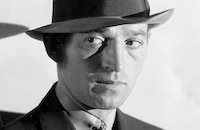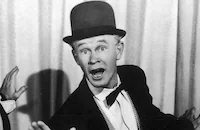Confessions of Boston Blackie

Brief Synopsis
Cast & Crew
Edward Dmytryk
Chester Morris
Harriet Hilliard
Richard Lane
George E. Stone
Lloyd Corrigan
Film Details
Technical Specs

Synopsis
In need of funds to send her tubercular brother Jimmy to a sanitarium, Diane Parrish hires art dealers Eric Allison and Buchanan to sell the family legacy, a statue of Augustus Caesar. Unknown to Diane, Allison and Buchanan are crooked dealers who have created a fake statue, which they plan to sell at auction while keeping the original for themselves. Among those attending the auction are Inspector Farraday and Detective Mathews, who have come to protect the artworks, Boston Blackie, a reformed safecracker, and his friend, eccentric millionaire Arthur Manleder, who has come to bid on the statue. As the bidding begins, Diane enters the room, approaches the statue and declares that it is a fake. To silence Diane, Buchanan pulls out his gun and shoots at her. Blackie shoots back at Buchanan, and although his bullet grazes Diane and kills Allison, Farraday has seen only Blackie's weapon and so assumes that he is the gunman. Blackie eludes Farraday and chases Buchanan, who knocks Blackie unconscious and climbs into a secret panel in the back of the statue. Farraday then enters the room, and when Blackie regains consciousness, he arrests him for Allison's murder. After they leave, Buchanan emerges from his hiding place and stuffs Allison's body in the statue, thus depriving Farraday of his corpus delicti. Unaware that Allison's body is hidden in the statue, Buchanan's accomplice, Caulder, the auctioneer, sells the fake to Manleder for $200, and the movers cart it away. When Buchanan learns of the transaction, he insists on recovering the statue to retrieve both his bullet from Allison's body and the combination to the vault from Allison's pocket. Meanwhile, at the police station, Blackie gives Farraday the slip by disguising himself in a uniform that he has stolen from the ice cream man and walking out the door. Upon returning to his apartment, Blackie is greeted by his sidekick, The Runt, and Mona, a showgirl who claims to be Blackie's wife and demands $6,000 in extortion money. To get rid of Mona, Blackie calls Manleder to borrow the money and suggests unveiling the statue at a cocktail party that afternoon. Blackie then goes to the hospital to visit Diane, and when he is denied admittance to her room, he steals another ice cream man's uniform and dons a surgical mask. Thinking that Blackie is a doctor, Diane tells him about Jimmy's tuberculosis and confides that she is selling the statue so that she can afford to put him in a sanitarium. When Diane notices the ice cream logo on Blackie's sleeve, he admits that he is Boston Blackie and asks for time to find her assailant. As Blackie leaves the hospital, Buchanan and Caulder follow him and, to eliminate the only eyewitness to Allison's murder, sideswipe his car and run it off the road. Emerging from the car unharmed, Blackie sends Runt to deliver the $6,000 that he borrowed from Manleder to Diane, instructing him to tell her that it is her insurance settlement. When Mona learns the fate of her extortion money, she visits Diane to demand its return and then informs Farraday of Blackie's deed. Meanwhile, at the cocktail party, Manleder tells Blackie that Caulder has offered him $500 for the statue. Blackie, suspicious, directs him to accept the offer and tell Caulder to pick it up that day. Hoping to trap Blackie, Farraday visits Diane at the hospital and arrests her as a material witness, but she escapes in a laundry hamper and takes a taxi to Manleder's house, where she is met by Blackie. After sending Diane to the safety of Blackie's apartment, he and Manleder follow the movers to Buchanan's warehouse. Blackie enters the building and instructs Manleder to call Farraday if he does not return in twenty minutes. At Blackie's apartment, Diane is greeted by Buchanan, who forces her into his car. When Runt sees them drive away, he realizes that something is amiss and begins to follow them. Arrested for running a red light, Runt is taken to the police station, where he meets Manleder, who has been arrested for loitering outside the warehouse. Meanwhile, Blackie has penetrated the inner depths of the warehouse, discovered the secret subterranean workshop and overpowered Caulder. Back at the police station, Farraday orders the release of Runt and Manleder and then follows Manleder to the warehouse. Before the police arrive, however, Buchanan enters, holding Diane as his hostage. In the ensuing struggle, Blackie knocks Caulder into the statue, sending it crashing to the floor and exposing Allison's body. At that moment, Farraday and his men arrive and Blackie explains that the bullet in Allison's body came from Buchanan's gun. After locating the combination in Allison's pocket, Blackie opens the vault which houses the original statue. Discovering that the gunshots have shorted out the electrical power, thus trapping them in the subterranean chamber, Blackie sends flames shooting through the ventilator, bringing the fire department to free them. After they are rescued, Farraday sheepishly thanks Blackie for saving his life.

Director

Edward Dmytryk
Cast

Chester Morris
Harriet Hilliard

Richard Lane

George E. Stone
Lloyd Corrigan

Joan Woodbury

Walter Sande
Ralph Theodore

Kenneth Macdonald
Walter Soderling

Billy Benedict
Mike Pat Donovan
Jack Clifford
Eddie Laughton
Jack O'malley
Al Hill

Ralph Dunn
Harry Hollingsworth
Budd Fine
Martin Spellman
Harry Bailey
Betty Mack
Dorothy Curtis
Bill Lally
Julius Tannen

Eddie Kane
Herbert Clifton
Jessie Arnold
Lorna Dunn
Gwen Kenyon
Harry Depp
Stanley Brown
Crew
Gene Anderson
Lionel Banks
William Berke
Ed Bernds
Jay Dratler
Gene Milford
Robert Peterson
M. W. Stoloff
Philip Tannura
Paul Yawitz
Paul Yawitz

Film Details
Technical Specs

Articles
Confessions of a Boston Blackie - Confessions of Boston Blackie
Confessions of Boston Blackie (1941) was one of a number of "B" pictures that Edward Dmytryk directed early in his career; it was his only entry in this particular series. This film offers good examples of both the constraints and opportunities that directors faced working on "B" programmers. The script is an absurd--but undeniably entertaining--mishmash of tubercular relatives, hidden panels in walls, ice cream vendors and showgirls, all crammed into an hour's running time. By the same token, films like this gave young directors practical experience in working quickly and professionally with a minimal budget, telling stories in a concise manner--since many of these films were only an hour long--and wherever possible, demonstrating a stylistic flair that might attract the attention of studio heads. While the Boston Blackie films certainly appealed to audiences of the day and still have something of a cult following, they were never favorites of the critics. For instance, the reviewer for the New York Times wrote on this film: "In more ways than one Confessions of Boston Blackie [...] resembles nothing so much as a chase in a nightmare. There is a lot of furious motion, but it doesn't get anywhere."
Biographical information for Jack Boyle, the author of the original Boston Blackie stories, is fairly scarce. Edward D. Koch, in his introduction to the 1979 reprint of the Boston Blackie stories, doesn't provide an exact birth date ("sometime prior to 1880"), but he mentions that Boyle grew up in Chicago and moved to San Francisco, where he covered Chinatown as a reporter. Boyle was present in the city during the great earthquake of 1906. He also became addicted to opium and was sentenced to prison more than once--first for bad checks, and later for armed robbery. Following the classic injunction to "write what you know," in 1914 he developed the character of the opium-addicted safecracker Boston Blackie for a series of stories in The American Magazine illustrated by the famed N. C. Wyeth. Boyle subsequently published fiction for Redbook and Cosmopolitan, and refashioned some of the Boston Blackie stories into a novel, which was published in 1919.
Film adaptations of the Boston Blackie stories date almost as far back as the stories themselves. In 1918, Metro Pictures released Boston Blackie's Little Pal, followed the subsequent year by Blackie's Redemption. Boyle himself collaborated on the script for the 1922 Boston Blackie film entitled The Face in the Fog, starring Lionel Barrymore. During the Twenties, Boyle wrote scripts for further Boston Blackie films, but his most interesting project appears to have been The Whipping Boss, a Monogram picture about harsh conditions at a prison lumber camp. Boyle later relocated to New York and is said to have passed away around 1928.
The character was resurrected in 1941 with Meet Boston Blackie, starring Chester Morris, who would play the character throughout the Forties. Morris (1901-1970) previously starred in the Roland West films Alibi (1929) and The Bat Whispers (1930). George E. Stone appears here for the first time as Boston Blackie's recurring sidekick "The Runt." A few years later, NBC built a radio show around the Boston Blackie character; a television series, starring Kent Taylor, aired starting in 1951.
Producer: William Berke
Director: Edward Dmytryk
Script: Paul Yawitz (story and script); Jay Dratler (story)
Based on the characters by Jack Boyle Photography: Philip Tannura
Art Direction: Lionel Banks
Film Editor: Gene Milford
Music: M. W. Stoloff
Principal cast: Chester Morris (Boston Blackie), Harriet Hilliard (Diane Parrish), Richard Lane (Inspector Farraday), George E. Stone (The Runt), Lloyd Corrigan (Arthur Manleder), Joan Woodbury (Mona), Walter Sande (Detective Mathews), Ralph Theodore (Buchanan), Kenneth MacDonald (Caulder), Walter Soderling (Eric Allison), Billy Benedict (Ice Cream Man).
BW-65m.
by James Steffen

Confessions of a Boston Blackie - Confessions of Boston Blackie
Quotes
I wouldn't trust you as far as I could throw one of those statues.- Inspector Farraday
Those lousy cigars you smoke are ruining your wind.- Boston Blackie
I'm chasing a woman.- The Runt
A woman, eh? Someday you'll thank me for this. (He arrests The Runt.)- Motorcycle cop
Trivia
Notes
The working title of this film was The Secret of Boston Blackie. This picture, the second in the series, marked the first appearance of George E. Stone as "The Runt," a role he played throughout the rest of the series. For additional information on the series, please consult the Series Index and see the entry below for Meet Boston Blackie.















